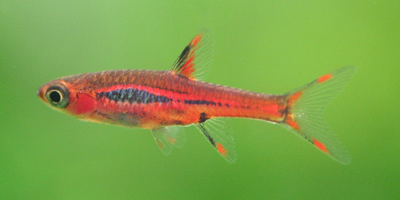Managaed to dig these up. It indicates PH and water conditions with regards to colors of the fish.
http://www.aquaticquotient.com/forum...ad.php?t=10466







Managaed to dig these up. It indicates PH and water conditions with regards to colors of the fish.
http://www.aquaticquotient.com/forum...ad.php?t=10466

thanks torque.. seems like i have a mixture of brigittae and uroph.. but strangly.. they tend to school together in big groups.. maybe too scared of my apisto

on 2nd look. it seems like mine are all boraras brigittae... but was wondering why some red some not..
It will take time for them to be fully acclimatised and get used to your tank's parameters.
Eventually they will all turn red and among all boraras spp., B. brigittae will turn out to be the most red in colour.

this 20 boraras has been in my tank for almost a month.. now the colour still not change.

okay.. just went to have a closer look at my boraras.
found out that i acctually have around 10 boraras. urophthalmoides and 10 boraras brgrittae.. thanks.. finally know why some are reder and some aren't.
Just be more patient with them and give them more time while keeping your water quality & condition good and slightly acidic. I kept 12 pcs of B. brigittae previously in a 40cm tank, they all turn out to be extremely reddish eventually. When I first got them from C328, they looked as white as those newborn fish.
Regards,
ZhaN

If you got them from the same batch, then it is unlikely they are mixed (unless the LFS mixed them together). Why I say that it is unlikely is because, B. brigittae, B. maculatus and B. merah are found in the Sunda region, i.e. Malaysia, Singapore, the Riau islands, Borneo and probably Sumatra. B. urophthalmoides and B. micros are found in the Indo-China region, i.e. Thailand, Cambodia and Vietnam.
(http://www.aquaticquotient.com/forum...ead.php?t=8480, see post 4)
Male B. brigittae are more colourful than the females. So you may just be seeing some sexual dimorphism.
B. urophthalmoides is also known as the exclamation point rasbora because their markings look like the exclamation point. So the dot near the caudal peduncle is very obvious and pronounced.
Also, a lot of pictures on the internet are mixed up and attributed wrongly. Here are two pictures that show exactly the differences between these two.
B. urophthalmoides (courtesy of MrTree)
B. brigittae (courtesy of budak)


thanks bro.. i bought 2 bags of 10 each from the same lfs at 2 different times. i used the line and redness of the boraras to indicate if its BU or BB. only to know that i have 2 different species mixed together.. had already sold of 10 of the boraras uroph.. will be getting brigittae soon. thanks

Just got some, just to share a picture




Ok think now its the correct fish

hi guys , can i ask you all , does the boraras briggitae swim freely in the water or does it hide in the leaves ? ( assuming no larger predator around )

for mine.. 20 of them they schools.. but 10 of them.. they hide.. but that is with a pair of apisto in the tank.
wonder why they hide , you got any big agressive fish in your tank ?

Yea,his apistos is the big aggressive fish.
Bookmarks